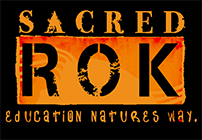At the end of the year we like to reflect on what we have learned, where we have been, and where we are going.
As the modern world unfolds with its technological advances, climate change, and wars and conflict, it continues to challenge us to our commitment of why we say “education nature’s way,” and what it means to be a human being.
With my good friend and Sacred Rok Board member Kenji Hakuta, who is a professor of education at Stanford University, we have inspired in each other the broader consideration of what it means to be educated nature’s way. More than once we have acknowledged the idea of “indigenous” in our conversations. That always motivates us to continue to work on the language and story that we have been building for the last five years.
Being with our kids in Yosemite points to the reality of how simple it can really be when we get back to the basics. It’s all about relationships based on respect, communication, and trust, which always seems to lead back to the reality of our indigenous connection to the earth.
We all came from a tribe at one time, a community that based itself on survival by respecting the environment. The distraction from this has created side effects that are affecting our youth and ourselves, some examples of which are called “attention deficit disorder” and even further, “nature deficit disorder.”
In my own personal experience and commitment to take the time to be in the sacred presence of the natural world, the profound beauty of Yosemite has a way of opening my senses to receive the medicine and healing that has a way of evoking my spirit — or just say energy — into a communing and communication that develops a relationship of profound connection.
Putting it simply, you can realize that this truly is a mother earth. When taking the time to consider that we are made up of the earth as human beings, and are 65% water, is for me personally what the potential of outdoor education can bring to our youth.
Another example is in my summer camp in Tuolumne Meadows. I get up before the sunrise, light the campfire, and have some coffee. As the sun begins to show, I walk down to the river barefoot, and sit on a rock that faces east, positioned with the river in front of me. As the sun comes over the mountain and begins to light up everything, there is a beam of light coming down the river over the water to where my feet are.
Holding my palms open and toward the sun, in my own way I imagine and feel all that is happening. The earth made a complete turn to bring a new day. The sun is hitting me, warming me, and I use my imagination to consider how it is providing life and light throughout the northern hemisphere and at the same time just for me.
After weeks of enjoying this personal ceremony, it dawned on me that I had a deeper understanding of the word “love”. I realized that these life-givers such as the sun, the moon, the air, the water, and the earth represent the idea of love in the most giving way that would be humanly possible to comprehend.
This is what I feel Kenji and I are getting at about what it means to be educated and what it means to be a human being. To find the deepest respect and appreciation for life and every living thing.
So sharing this beauty and healing that can evoke the human spirit into being human seems to me at this particular time in our history to be not only a responsibility, but an obligation we take seriously, to nurture our children and inspire their authentic self.
We bring this into the context of learning and building relationships to the sacredness of nature and the reality that we all belong to an extended family that goes beyond humans to every living thing. This creates an inner strength so we can see clearly the value of who we are as unique individuals.
Kids are the future. This is our commitment to education in the 21st century, which can help us all to reconsider our priorities and values that have everything to do with our responsibilities to the past, the present, and the future.
This may sound serious, but so is climbing El Capitan. In my own teenage years, I had a place to go and find something to literally and figuratively hang on to. Climbing the 3,000 foot rock face of El Capitan presented the kind of challenge that could test a youth in a positive, respectful, and humble way in the environment of the vertical world. Learning how to get back to the basics – food, water, shelter, and survival skills – necessary to make such a journey.
Forty years later, I continue to seek the wisdom from these profound challenges. Considering the world we live in, we at Sacred Rok are having serious fun looking for ways to be responsible to future generations.
Thank you for reading these thoughts. We are working on our story, following the tracks laid out before us in Yosemite and illuminated through the narrative of sharing with our youths.
As we shared with you earlier, we have a new t-shirt on the website. Let us know if you want one. And check out our annual reports.
Also, please consider making a year-end contribution to support our work! You can pay by PayPal on our website, or mail a check to Sacred Rok at PO Box 148, Yosemite, CA 95389.
As one of our guys from juvenile hall said, “It is all for one and one for all” – that is how we feel about being together. Basically, we are just setting out on the trail together.
Thank you again for all your support.
– Ron Kauk













